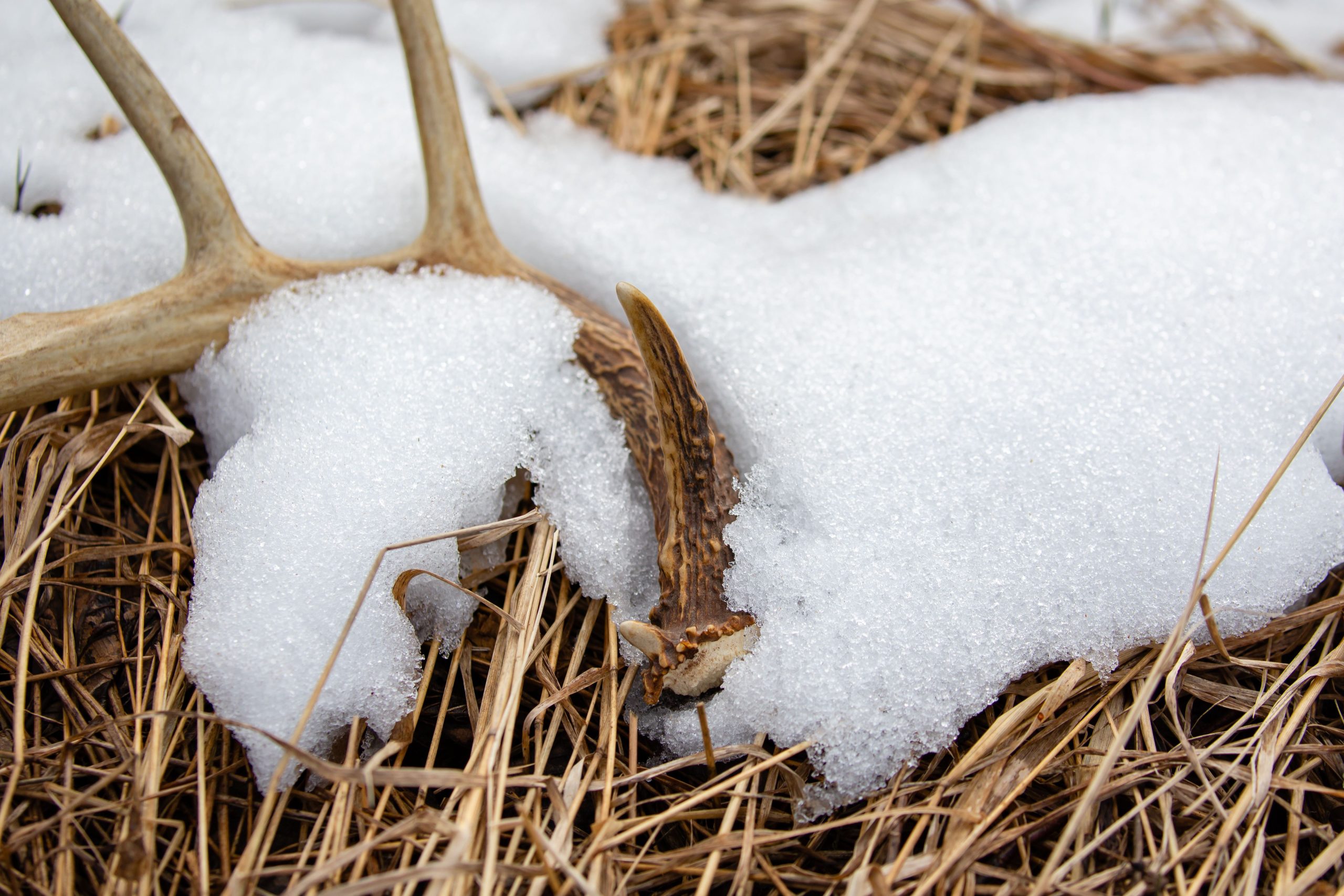Public Land Shed Hunting Strategies

Public Land Shed Hunting Strategies
It was the winter of 2015 and my wife and I were living in a third-floor apartment in Bettendorf. Although we were in the middle of city living. I still had a strong pull to get out in the woods and try this new pursuit. Hearing about it from a friend, he called it shed hunting. I read literally every shed hunting article I could find at the time. I began my first few voyages into the local city park timberlines and creek bottoms. Fruitlessly scouring for my first glimpse of a shed antler. What started out as a few off trail hikes with my wife quickly evolved into an almost daily obsessive bushwhacking quest to find just one antler. After a month of scouring the same city park and seeing other tracks in the snow. I wonder if every shed that was dropping was found by others sharing my mission objective. It was public land after all and there was a good chance this wasn’t my competition’s first season of shed hunting, so how could I gain an edge? You can get ahead of the competition with these public land shed hunting strategies.
Competition
Competition is a foundational principle of nature. I don’t think God intended it to be that way, but since the fall of creation it became a necessary mechanism to sustain ecosystems. As humans we have taken competition to a whole new level. We not only compete over food, water, mates, and habitat like other critters in our natural community. We also compete over things like employment opportunities, elected offices, youth sports, landscaping and fantasy football. For better and worse, competition shapes nearly all aspects of decision making on a daily basis. The competition that arises between hunters on public land is probably one of the most natural forms of competition. But outside of hunting for calories, we hunters get caught up in the trophy competition. As well as finding ourselves comparing our biggest bucks, sheds, and rooster tails with the other hunters on social media. Regardless of this reality, the fact remains that if we limit ourselves to shed hunting on public land we are going to have to find ways to outcompete the other shed hunters we are sharing the ground with. The first place to start is by knowing the habits of the other shed hunters. Primarily two questions need to be answered: 1. Where are they most likely to look? And 2. When will they be looking?
From my experience I have observed that nearly every piece of public ground is shed hunted by at least a couple good shed hunters. These folks know where the premium pieces of habitat, or the most desirable food sources are located and how the deer come and go from these locations. Their ability to key in on these locations definitely makes them tough to compete with, but not impossible. Start by planning your search in those most premium areas. Then work out from them in a way that seems to favor a buck’s preferred travel route (sometimes these are heavily traveled trails, other times they may be solo deer trails: examine the tracks and look for large hoof prints with deep dew claw marks that match the body weight of an old heavy buck), and work into small areas of isolated habitat that a buck would choose to bed in instead of broad flats with abundant thermal cover that a doe family group is looking for. At this point into the search pay close attention to overlooked habitat features such as a small patch of cedars in a mostly deciduous hardwood timber, or a small clearing with southern exposure, even areas that are just simply out of the cold winter wind may provide a perfect buck bed. The same strategy can be used on overlooked food sources. These include foliage like red oaks that still have some acorns left on the ground well into the winter. Or maybe a patch of clover or other green food source that stays green deep into winter.
Finding the Right Areas
Perhaps the simplest adjustment for seeking out overlooked public acres to hunt sheds is by leaving the state WMAs (wildlife management area), state forests, or even federal lands that allow hunting, and focusing on public areas that have good habitat but do not allow hunting. These areas can serve as sanctuaries for deer and the average shed hunter will often overlook them. Such locations might include city parks and easements, wooded bike trails, county campgrounds and conservation areas, or even wildlife refuges. If you are uncertain if a specific piece of publicly owned land is available for shed hunting call the local authorities and check with them before looking.
Beyond finding the right spots, going at the right time is also critically important when you’re shed hunting on public ground. I once read a great tip from Meateater’s Tony Peterson who suggested that shed hunting public land during the day on Thursdays provided the best timeframe for looking. This is because most folks will be out looking on the weekends and a Thursday shed hunt would allow for the most time to pass since the weekend crowd walked the area and a few more bucks may have shed in that window of time. Employing this strategy as shed season gets deep into March. This may be worth taking a day off from work to try and search during this timeframe. The other timing trick that can be worthwhile is starting the season early and ending it late. Sheds drop over a wide window of time, wider than I think most shed hunters realize. Injured or severely stressed bucks will drop as early as December. When most guys are focusing on closing out the fall hunting season. Other bucks may hang onto their antlers until April when most folks have started changing gears focusing on turkey hunting. So, hitting the woods for sheds while most everyone else is focusing on hunting can provide you a competitive edge.
Scouting
Scouting is a skill that sets expert hunters apart from the rest of us and it lands them opportunities to kill the cagiest bucks in the woods on a regular basis. Using Scouting to find shed hunting locations is equally important. Especially to efficiently cover the most prime acres to avoid wasting time searching areas with low deer densities. This is true on private land of course, but the limited access there allows a shed to sit longer. The most effective scouting I have done to help key in on the highest odds spots before searching them. Begin with a lot of time spent looking at digital mapping apps like onX or Spartan Forge. Once I have a handful of locations I want to check out, I try to study them in person. I want to know what the primary cover is, how close it is to food sources, how many parking areas or access trails there are, and how it networks with other surrounding habitat that I won’t be able to access. gathher this information quickly through a quick drive past the location, or a 30-minute speed hike after work. If I see what I like in a high odds shed area. Usually, I will do some additional e-scouting and plan a return trip when I can spend more time searching the place over. Providing I find a particularly good spot I will turn on my e-scouting app’s tracking feature. This is to make sure I thoroughly cover the best spots, and walk new “lines” each time I revisit locations. If a new public land spot doesn’t produce as well as my scouting suggested. Usually, I will try to move to a new spot after 2-3 fruitless shed hunts. Having another area you have had the chance to scout can help make the switch as efficient as possible and keep me hot on the trail for freshly shed antlers.
Hunting for antlers while they are still attached to a buck’s skull is my final tip for improving success rates shed hunting Public Land. Any bucks that are seen during the fall archery season or gun season become potential targets. Especially when the antlers drop from their heads a few months later. Chances are a handful of bucks will be spotted on a recurring basis during the hunting season. Making their behavior much easier to pattern. This time spent watching them from the tree stand can help pinpoint bedding areas they prefer, feeding sources and favorite travel corridors linking them together. Pairing this knowledge from observation with some trail cameras. Using trail cameras in and around these areas can help provide notice when a buck has dropped his antlers. Once the antlers are on the ground it’s time to get into his favorite locations as quickly as possible to be the first one to the antlers.
Shed hunting public land definitely presents a more challenging opportunity than private land searches do. However, with a well thought out plan the potential for all public land pieces can maximize the sheds found. Even with a good plan the most important tactic to use is walking plenty of miles. As the oft repeated phrase goes- “miles for the piles” and that’s ultimately what brought me to my first ever shed back in that same city park I’d searched countless times that winter. That fever I caught then still pulls me into the woods today.
By Kent Boucher
March 2025


